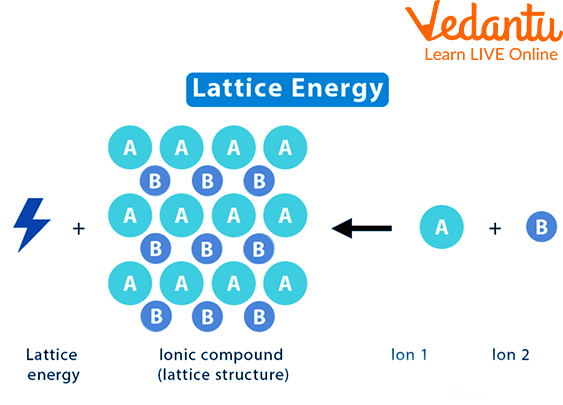




How Does Lattice Energy Affect Ionic Compound Stability?
We are surrounded by Chemistry and chemical energy; in fact, we are made of it. Chemical energy is a common occurrence in daily life. A chemical change occurs when chemical compounds act and react at the molecular level. Batteries, food, wood, fireworks, cars, and other goods we use daily contain chemical energy.
Lattice energy is the energy difference between the ionic solids' actual observed energy and their expected experimental value. In more detail, this is the energy difference between the energy of the ionic solid and the energy of the individual gaseous ions. Now let’s understand more about lattice energy in this article.
What is Lattice Energy in Chemistry?
The energy needed to transform one mole of an ionic solid into gaseous ionic components is known as lattice energy. The energy that must be provided to one mole of an ionic crystal in order for it to undergo an endothermic process that separates it into gaseous ions can also be used to characterise it. As a result, this amount has a positive value at all times.
Some sources describe lattice energy in the opposite way, i.e., as the amount of energy released during the exothermic formation of an ionic solid from its gaseous ionic components.
This definition requires that lattice energy always has a negative value.

Lattice Energy
What Elements Have an Impact on Lattice Energy?
The amount of charge carried by the constituent ions and the space between them both majorly affect the lattice energy of an ionic combination.
Charge Held by the Constituent Ions
The single ions in an ionic lattice are drawn to one another due to the electrostatic forces between them. The amount of charge that each of the constituent ions carries directly relates to the intensity of the electrostatic force of attraction; thus, the more charge, the stronger the force of attraction and the more rigid the lattice.
The Distance Between the Ions
The spacing between the ions has an inverse relationship with the lattice energy of an ionic molecule. The longer the distance between the ions in a lattice, the weaker the electrostatic forces binding them together and the lower the lattice energy.
Terms of Chemistry
Crystal
Any solid whose surface regularity mirrors its internal symmentry and whose constituent atoms are arranged in a specific manner.

Crystal
Matter
The observable universe is made up of matter, which, coupled with energy, serves as the foundation for all objective occurrences.
Dual Refraction
A phenomenon in optics where a single unpolarised light beam splits into two beams that go in different directions upon entering an anisotropic medium.
Diffraction of X-rays
A phenomenon where the regular spacing of the atoms in a crystal causes the waves in an incident X-ray beam to interfere with one another.
Summary
Compounds made of ionic solids are particularly stable. The approximate strength of the ionic bond is determined by the solid structure's lattice energy. The energy change that occurs during the exothermic process of creating an ionic compound from gaseous ions is known as the lattice energy. It is also known as the endothermic energy required to break down an ionic substance into gaseous ions. Lattice energy measurement is challenging, though.
It is important to know about this as it is the unit of our environment. Through this article, we are aware of the term lattice energy. It is a very important Chemistry topic requiring a thorough reading, so here we are with this article.
FAQs on Lattice Energy: Meaning, Formula & Applications
1. What is meant by lattice energy in chemistry?
Lattice energy is defined as the energy required to completely separate one mole of a solid ionic compound into its constituent gaseous ions. It is a measure of the strength of the electrostatic forces holding the ions together in a crystal lattice. Alternatively, it can be defined as the energy released when one mole of an ionic compound is formed from its gaseous ions. By the first definition, lattice energy is always a positive value (endothermic process).
2. What are the key factors that affect the magnitude of lattice energy?
The magnitude of lattice energy is primarily influenced by two main factors:
- Ionic Charge: The lattice energy increases significantly with the increase in the magnitude of the charge on the ions. For example, the lattice energy of MgO (Mg²⁺O²⁻) is much higher than that of NaCl (Na⁺Cl⁻).
- Ionic Radius: The lattice energy decreases as the size of the ions (and thus the distance between them) increases. Smaller ions can get closer to each other, resulting in stronger electrostatic attraction and higher lattice energy.
3. How is lattice energy related to the stability of an ionic compound?
Lattice energy is a direct indicator of the stability of an ionic solid. A higher lattice energy signifies stronger electrostatic forces of attraction between the ions in the crystal lattice. This strong bonding means more energy is needed to break the lattice apart, resulting in a more stable compound with physical properties like a high melting point and hardness.
4. What is the difference between lattice energy and lattice enthalpy?
Lattice energy and lattice enthalpy are very similar concepts that both quantify the strength of an ionic lattice, but they differ slightly in convention. Lattice enthalpy is the enthalpy change (ΔH) for the process, which is always positive by definition (endothermic). Lattice energy (U) is often expressed as a negative value, representing the energy released during lattice formation (exothermic). Essentially, for the same process, Lattice Enthalpy = - Lattice Energy.
5. Why can't lattice energy be measured directly in a laboratory experiment?
Lattice energy cannot be measured directly because it is practically impossible to form one mole of a solid ionic crystal from its constituent gaseous ions in a single, measurable step. Similarly, converting the entire crystal back into a gaseous cloud of ions is not feasible under standard lab conditions. Therefore, it is calculated indirectly using theoretical models or thermodynamic cycles like the Born-Haber cycle.
6. How is the Born-Haber cycle used to determine lattice energy?
The Born-Haber cycle is a practical application of Hess's Law. It relates the lattice energy of an ionic compound to other known thermodynamic quantities. It constructs a closed energy cycle that includes the standard enthalpy of formation, ionisation energy, electron affinity, and enthalpy of atomisation. By knowing the values for all other steps in the cycle, the unknown lattice energy can be calculated accurately.
7. How does lattice energy trend down a group in the periodic table for similar compounds?
For similar ionic compounds (e.g., alkali metal halides like LiF, NaF, KF), the lattice energy generally decreases as you move down a group. This is because the ionic radius increases down a group. The larger ions result in a greater distance between the ionic centres, which weakens the electrostatic forces of attraction holding the crystal together.
8. Why is the lattice energy of MgO significantly higher than that of NaF, even though their ions are of similar size?
The lattice energy of MgO is much higher than that of NaF primarily due to the greater magnitude of charges on the ions. MgO is formed from Mg²⁺ and O²⁻ ions, while NaF is formed from Na⁺ and F⁻ ions. Since lattice energy is directly proportional to the product of the ionic charges (q₁q₂), the (2+) x (2-) interaction in MgO is four times stronger than the (1+) x (1-) interaction in NaF, leading to a much more stable lattice.
9. What are some important applications of knowing a compound's lattice energy?
Knowing the lattice energy is important for several reasons in chemistry:
- It helps in understanding and predicting the stability and properties (like melting point and hardness) of ionic compounds.
- It is used to explain the solubility trends of ionic solids in different solvents.
- It is a crucial component in the Born-Haber cycle for calculating other thermodynamic values, such as electron affinities, which are difficult to measure experimentally.
























